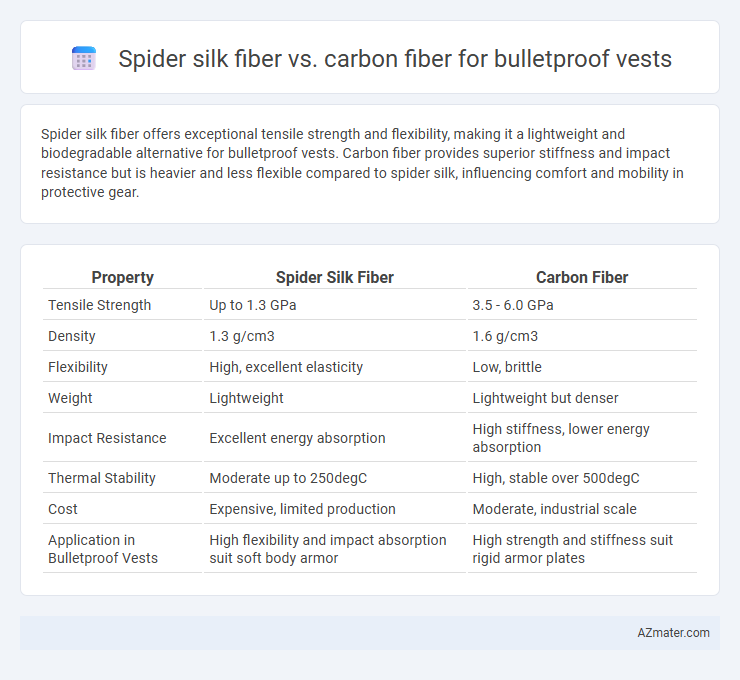Spider silk fiber offers exceptional tensile strength and flexibility, making it a lightweight and biodegradable alternative for bulletproof vests. Carbon fiber provides superior stiffness and impact resistance but is heavier and less flexible compared to spider silk, influencing comfort and mobility in protective gear.
Table of Comparison
| Property | Spider Silk Fiber | Carbon Fiber |
|---|---|---|
| Tensile Strength | Up to 1.3 GPa | 3.5 - 6.0 GPa |
| Density | 1.3 g/cm3 | 1.6 g/cm3 |
| Flexibility | High, excellent elasticity | Low, brittle |
| Weight | Lightweight | Lightweight but denser |
| Impact Resistance | Excellent energy absorption | High stiffness, lower energy absorption |
| Thermal Stability | Moderate up to 250degC | High, stable over 500degC |
| Cost | Expensive, limited production | Moderate, industrial scale |
| Application in Bulletproof Vests | High flexibility and impact absorption suit soft body armor | High strength and stiffness suit rigid armor plates |
Introduction: Evolution of Bulletproof Vest Materials
Spider silk fiber and carbon fiber represent two cutting-edge materials in the evolution of bulletproof vest technology, each offering unique advantages in strength and flexibility. Spider silk fiber exhibits exceptional tensile strength and lightweight properties, making it an innovative choice for enhancing wearer comfort and mobility. Carbon fiber is widely known for its superior rigidity and impact resistance, providing robust protection while maintaining a lightweight profile suitable for ballistic applications.
Understanding Spider Silk Fiber: Structure and Properties
Spider silk fiber, composed primarily of fibroin proteins arranged in a highly ordered beta-sheet crystalline structure, exhibits exceptional tensile strength and elasticity, outperforming many synthetic fibers including carbon fiber in flexibility and impact absorption. Its molecular composition allows for energy dissipation through deformation, making it an ideal candidate for bulletproof vest materials that require both durability and lightweight characteristics. Compared to carbon fiber, which is stiff and brittle under impact, spider silk offers superior toughness and biodegradability, enhancing wearer comfort and environmental sustainability.
Overview of Carbon Fiber: Composition and Strength
Carbon fiber is composed of thin strands of carbon atoms tightly bonded in a crystalline formation, resulting in exceptional tensile strength and lightweight properties. Its strength-to-weight ratio surpasses many conventional materials, making it ideal for bulletproof vests requiring durability and flexibility. The high stiffness, resistance to impact, and ability to absorb energy efficiently position carbon fiber as a leading material in advanced personal armor technologies.
Comparative Analysis: Tensile Strength of Spider Silk vs Carbon Fiber
Spider silk exhibits tensile strength ranging from 1.0 to 2.0 GPa, showcasing exceptional flexibility and energy absorption, while carbon fiber offers higher tensile strength between 3.5 to 6.0 GPa, enabling superior rigidity and load-bearing capacity. The remarkable toughness of spider silk, measured by its ability to stretch up to 30%, provides enhanced impact resistance in bulletproof vest applications compared to the brittle nature of carbon fiber, which typically stretches less than 2%. Combining spider silk's elasticity with carbon fiber's strength represents a promising approach to optimize both durability and flexibility in advanced body armor technology.
Flexibility and Comfort: Wearability in Protective Gear
Spider silk fiber offers exceptional flexibility and lightweight comfort compared to the rigid structure of carbon fiber, making it more suitable for bulletproof vests designed for extended wear. Its high tensile strength combined with stretchability allows protective gear to conform closely to body movements without sacrificing durability. Carbon fiber, while strong and impact-resistant, tends to be stiffer and less breathable, reducing overall wearability and comfort during prolonged use.
Weight Considerations: Lightweight Protection Factors
Spider silk fiber offers exceptional tensile strength combined with remarkable lightness, making it an ideal candidate for lightweight bulletproof vest applications where mobility and comfort are paramount. Carbon fiber, while also strong and rigid, typically exhibits higher density, which can increase the overall weight of protective gear, potentially reducing wearer agility. Advances in synthetic spider silk production focus on maximizing strength-to-weight ratios, enabling bulletproof vests that provide effective protection with significantly less bulk compared to traditional carbon fiber composites.
Biocompatibility and Environmental Impact
Spider silk fiber exhibits exceptional biocompatibility due to its natural protein structure, minimizing skin irritation and allergic reactions in bulletproof vest applications. Carbon fiber, while offering high strength and durability, can cause skin abrasions and is less environmentally friendly due to its energy-intensive production and limited recyclability. The biodegradability of spider silk ensures a significantly lower environmental impact compared to carbon fiber's synthetic and non-biodegradable nature.
Manufacturing Challenges and Scalability
Spider silk fiber offers exceptional tensile strength and elasticity, but its commercial production faces significant manufacturing challenges due to the complex protein synthesis and difficulties in replicating natural spinning processes at scale. Carbon fiber, with its established industrial fabrication techniques, benefits from mature scalability and consistent quality control, making it more practical for mass production of bulletproof vests. However, carbon fiber's brittleness and heavier weight compared to spider silk limit its flexibility and comfort in wearables.
Real-world Performance: Ballistic Resistance Comparison
Spider silk fibers exhibit exceptional tensile strength and flexibility, enabling high energy absorption and impact resistance crucial for bulletproof vest applications. Carbon fibers deliver superior stiffness and hardness, providing excellent penetration resistance but limited flexibility, which can result in brittleness under ballistic impact. Real-world tests show spider silk composites absorb impact forces more efficiently, reducing blunt force trauma, while carbon fiber materials offer higher initial stopping power but may crack or shatter under repeated strikes.
Future Prospects: Innovations in Bulletproof Vest Technologies
Spider silk fiber's exceptional tensile strength and flexibility make it a promising candidate for next-generation bulletproof vests, offering lightweight and durable protection compared to traditional carbon fiber composites. Innovations combining bioengineered spider silk with advanced nanomaterials aim to enhance impact resistance and energy dispersion, potentially surpassing the performance of carbon fiber-based armors. Research in synthetic silk production and hybrid fiber matrices is accelerating the development of eco-friendly, high-performance ballistic materials for future defense applications.

Infographic: Spider silk fiber vs Carbon fiber for Bulletproof vest
 azmater.com
azmater.com